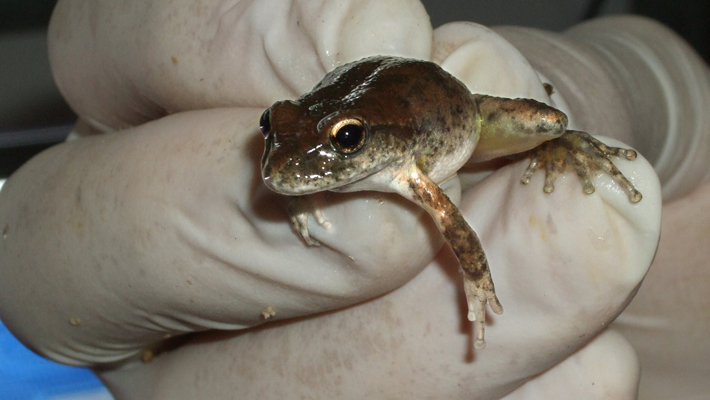Frog Recovery
Zoo-based amphibian conservation breeding programs play a critical role in supporting ongoing management and, in some cases, re-establishment of wild populations of several threatened frog species. Advances in amphibian assisted reproductive technologies are set to bolster conservation outcomes from breed-for-release programs primarily by ensuring populations remain genetically diverse and adaptive to the suite of environmental stressors that continue to drive declines.
With funding from the Zoo and Aquarium Association (ZAA) Wildlife Conservation
Fund’s Australian Bushfire Crisis grant and Taronga, this project primarily addresses the detrimental impacts to population health and sustainability that occur in response to the loss of genetic variation over time, whether in zoo-based or wild environments. The purpose of this project is to develop, refine and apply established sperm collection and cryopreservation techniques to capture the genetic diversity of individuals within existing breed-for-release programs of the Environment Protection and Biodiversity Conservation Act-listed species at Taronga Zoo and Zoos Victoria.
The target species for this program; the Booroolong Frog, Northern and Southern Corroboree Frog, Spotted Tree Frog and the Yellow-spotted Bell Frog, have declining population trajectories, with declines exacerbated by recent drought and bushfire events for the former four species. Through sperm biobanking from live males, the main outcome of this project will be to permanently preserve extant genetic variations. Biobanking rich sets of genotypes will result in tangible conservation impacts as samples are reintroduced through assisted fertilisation in a strategic and genetically-underpinned manner over time; positively impacting the long-term fitness of wild populations and reducing the risk of extinction.

Publications and resources
- Della Togna, G., Howell, L.G., Clulow, J.C., Langhorne, C.J., Marcec-Greaves, R. and Calatayud, N.E., 2020. Evaluating amphibian biobanking and reproduction for captive breeding programs according to the Amphibian Conservation Action Plan objectives. Theriogenology. DOI: 10.1016/j.theriogenology.2020.02.024
- Scientific foundations of zoos and aquariums: Their role in conservation and research: Hobbs, R. J., Spindler, R. E. and O’Brien, J. K. (2019). Chapter 4: Strategic Gene Banking for Conservation: The Ins and Outs of a Living Bank. In: Scientific Foundations of Zoos and Aquariums: Their Role in Conservation and Research. Cambridge University Press. A. Kaufman, T. Maple and M. Bashaw (eds). Pp. 112-146. DOI: 10.1017/9781108183147.005